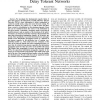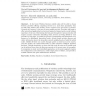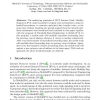TMC
2012
11 years 7 months ago
2012
—We present the boomerang protocol to efficiently retain information at a particular geographic location in a sparse network of highly mobile nodes without using infrastructure ...
INFOCOM
2010
IEEE
13 years 2 months ago
2010
IEEE
We investigate the fundamental capacity limits of space-time journeys of information in mobile and Delay Tolerant Networks (DTNs), where information is either transmitted or carrie...
TIFS
2008
13 years 4 months ago
2008
We consider the problem of secret key distribution in a sensor network with multiple scattered sensor nodes and a mobile device that can be used to bootstrap the network. Our main...
MONET
2006
13 years 4 months ago
2006
In the future Wireless Internet, mobile nodes will be able to choose between providers offering competing services at a much finer granularity than we find today. Rather than month...
CORR
2010
Springer
13 years 4 months ago
2010
Springer
Mobile ip (mip) is an internet protocol that allows mobile nodes to have continuous network connectivity to the internet without changing their ip addresses while moving to other ...
GECCO
2008
Springer
13 years 5 months ago
2008
Springer
We present a force-based genetic algorithm for self-spreading mobile nodes uniformly over a geographical area. Wireless mobile nodes adjust their speed and direction using a genet...
NETWORKING
2000
13 years 5 months ago
2000
The underlying principles of IETF Internet Draft, Mobility Support in IPv6, make it possible to employ some mechanisms to improve handoff smoothness, to maintain optimized data tra...
NETWORKING
2007
13 years 6 months ago
2007
One of the current challenge of the Mobile IPv6 Working Group at the IETF is to dynamically assign to a Mobile Node its Home Agent, Home Address and to setup necessary security ass...
INFOCOM
1998
IEEE
13 years 8 months ago
1998
IEEE
Mobile nodes of the future will be equiped with multiple network interfaces to take advantage of overlay networks, yet no current mobility systems provide full support for the sim...
SIGMETRICS
2003
ACM
13 years 9 months ago
2003
ACM
—Node movement can be exploited to reduce the energy consumption of wireless network communication. The strategy consists in delaying communication until a mobile node moves clos...



